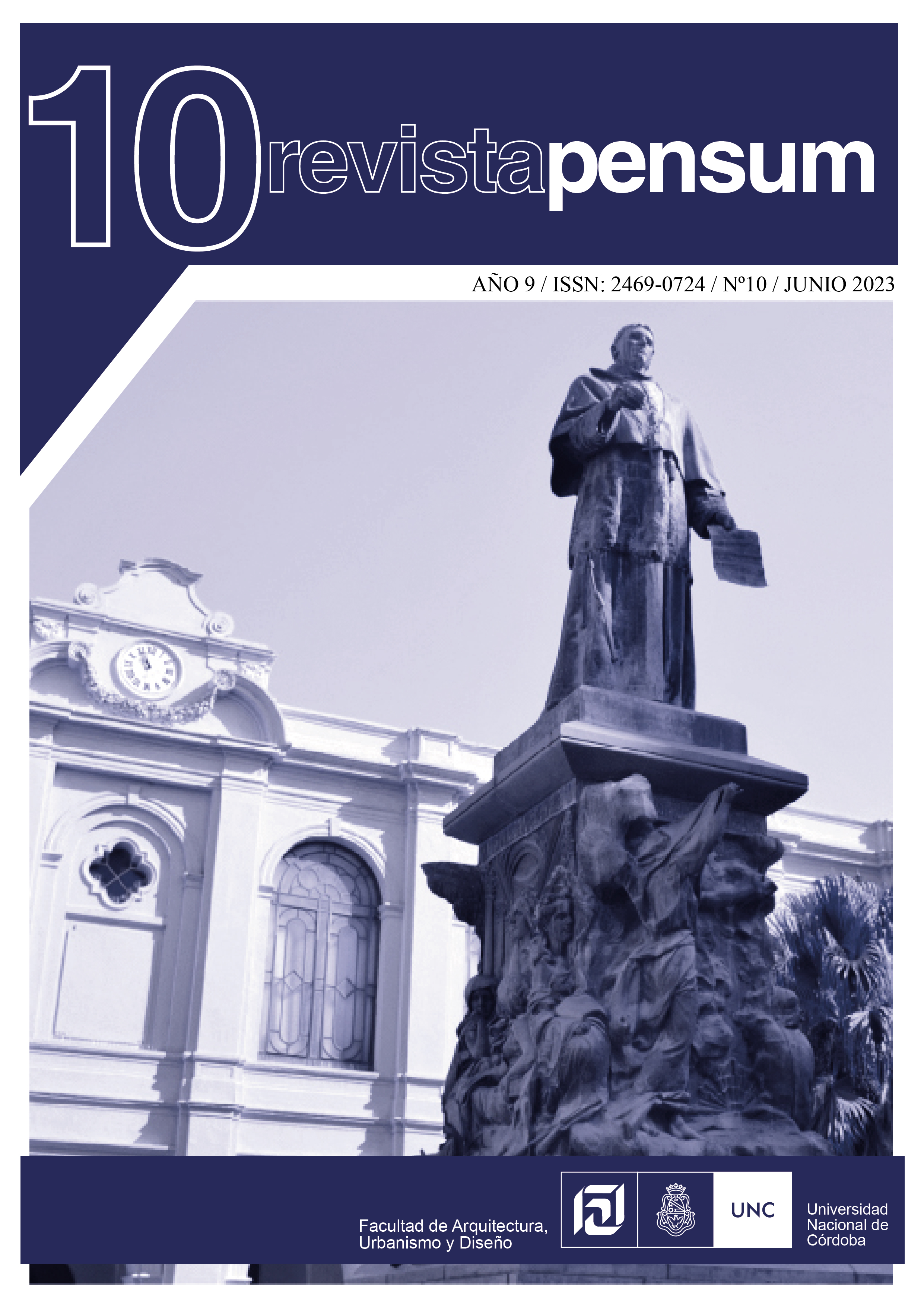Energy and sustainable performance of a housing project in an arid climate.
Redesign by simulation.
DOI:
https://doi.org/10.59047/2469.0724.v9.n10.41116Keywords:
bioclimatic design, thermal energetical simulation, dry weather, solar incidence, redesignAbstract
The present work shows an analysis of the thermal-energy, lighting and sustainable performance of a private housing project for permanent residence on the outskirts of the city of San Juan, Argentina, the improvement proposal and their evaluation. This evaluation is based on the implementation of multiple bioclimatic design tools from Givoni, IRAM, ASHRAE, and internationally recognized hygrothermal energy simulation like Energy+ and lighting evaluation with ECOTECT. The analysis of results was specified in 18 recommendations that are reflected in the project. Finally, these results and the consequent expected energy savings are analyzed. The main results are to avoid overheating and excessive consumption of air conditioning in summer, as well as dazzling its inhabitants. Since electricity is used as a heating source, it is crucial to reduce consumption and incorporate photovoltaic solar energy. Significant energy savings close to 50% are observed. The minimum consumption of air conditioning and the reduction of the peaks of energy demand in winter stand out. Total, loads per m2 decreased from 433 to 262 KWh/m2 year. The project is currently under construction following the suggested design recommendations.
Downloads
References
Badescu V., Laaser N., Crutescu R., Crutescu M, Dobrovicescu A.y Tsatsaronis G. (2011). Modeling, validation and time dependent simulation of the first large passive building in Romania. Renew Energy; 36(01), 142-157.
Banco mundial. (2021). https://www.bancomundial.org/es/home
Carruthers, D. D., Roy, G. G., y Uloth, C. J. (1985). An evaluation of formulae for solar declination and the equation of time (Research Report No. 17). School of Architecture, The University of Western Australia.
Correa Cantaloube, E. (2022). Conceptos fundamentales. En E. Correa Cantaloube (Comp.), Bioclimatología aplicada al diseño urbano sustentable, herramientas de valoración energética y ambiental. INAHE-CONICET.
Curso de certificadores, 2020. Etiquetado de viviendas. Ministerio de Economía. Secretaría de Energía. Cursado en 2020 edicion actualizada.
Dury, A. (2014-2022) WMO Region 3 - South America. EU.: Climate.OneBuilding.Org. http://climate.onebuilding.org/WMO_Region_3_South_America/ARG_Argentina/index.html
ECOTECT Building Analysis for designers v5 [software]. https://es.freedownloadmanager.org/Windows-PC/Autodesk-Ecotect-Analysis.html recuperado el 26/09/2022
EnergyPlus. (2022). EnergyPlus 22.2.0 [software]. EnergyPlus. https://energyplus.net/
Fachinotti, V. D., Bre, F., Mankel, C., Koenders, E. A. B., & Caggiano, A. (2020). Optimization of Multilayered Walls for Building Envelopes Including PCM-Based Composites. Materials, 13(12), 2787. https://doi.org/10.3390/ma13122787
Gónzalez Leonardo, M., López-Gay, A., Recaño Valverde, J., & Rowe, F. (2022). Cambios de residencia en tiempos de COVID-19: Un poco de oxígeno para el despoblamiento rural. Perspectives Demogràfiques, 1-4. https://doi.org/10.46710/ced.pd.esp.26
IPCC. (2022) Synthesis Report of the Sixth Assessment Report. IPCC. https://www.ipcc.ch/ar6-syr/ [21/10/2022].
Klõšeiko, P., & Freudenberg, P. (2019). Generative reverse-modelling approach to hygrothermal material characterization. MATEC Web of Conferences, 282, 02088. https://doi.org/10.1051/matecconf/201928202088
Lam J.C., Yang L., Liu J. (2006). Development of passive design zones in China using bioclimatic approach. Energy Convers Manage; 47(04):746- 62.
Negrin, I., Negrin, A., & Chagoyén, E. (2019). Optimización metaheurística de conjuntos estructurales de hormigón armado Metaheuristic optimization of structural sets of reinforced concrete. 34.
Omrany H.; Marsono A.K. (2016). Optimization of Building Energy Performance through Passive Design Strategies. British Journal of Applied Science & Technology 13(6): 1-16.
Open Studio 3.5.0 [software]. https://openstudio.net/ recuperado el 24/4/2023
Sadineni SB, Madala S, Boehm RF. (2011). Passive building energy savings: A review of building envelope components. Renewable and Sustainable Energy Reviews; 15(08):3617-31
Secretaría de Ambiente y Desarrollo Sustentable et al. (2016). MANUAL DE VIVIENDA SUSTENTABLE. C.A.B.A. – República Argentina. Recuperado de: https://www.argentina.gob.ar/sites/default/files/manual_de_vivienda_sustentable_2.pdf
Sulaiman H, Oga Martinez L, (2022). simulación higrotérmica vs. etiquetado de vivienda nacional, análisis crítico de metodologías y herramientas. XLIV Reunión de Trabajo de la Asociación de Energías Renovables y Ambiente (ASADES).
Sulaiman H, Oga Martinez L, (2023). ¿Utopía o realidad? Factibilidad de un proyecto de vivienda multifamiliar con materiales reciclados en el centro de Argentina. [En prensa]. Revista 180.
Sulaiman H.; Sánchez Amono M. P.; Gaggino R.; Oga Martínez L. (2019). Evaluación térmico-energética de un prototipo de vivienda sustentable con materiales reciclados. R, C, S (Ed), Euro elecs 2019 III Encuentro Latinoamericano y Europeo sobre Edificaciones y Comunidades Sostenibles.
Sulaiman, H., Sipowicz, E., Filippín, C. y Oga, L. (2020). Energy Performance of Dwellings in a Temperate Climate Area of Argentina. An Architectural Proposal. The Open Construction and Building Technology Journal.
Taha, H. A., & Navarro Salas, R. (2015). Investigación de operaciones (9a. ed.). Pearson Educación.
Valentina Garrido Oyarzo (31 de marzo, 2023), tesis magister, Trayectorias y elecciones residenciales de los nuevos residentes de las parcelas de agrado durante la pandemia del COVID-19: el caso de Puerto Varas. Instituto de Estudios Urbanos y Territoriales Pontificia Universidad Católica de Chile
Tejavathu RU., RavI, P., Shukla, K. (2010) Life cycle energy analysis of buildings: an overview. EnergyBuild, 42(10):1592 600.
Trimble Inc. (2022). Sketchup. [software]. https://www.sketchup.com/es
Valentina Garrido Oyarzo (31 de marzo, 2023), tesis magister, Trayectorias y elecciones residenciales de los nuevos residentes de las parcelas de agrado durante la pandemia del COVID-19: el caso de Puerto Varas. Instituto de Estudios Urbanos y Territoriales Pontificia Universidad Católica de Chile
Published
How to Cite
Issue
Section
License
Copyright (c) 2023 Halimi Sulaiman, Lautaro Oga Martinez, Alicia Pringles

This work is licensed under a Creative Commons Attribution-ShareAlike 4.0 International License.
Authors who publish in this journal agree to the following terms:
a. Authors retain copyright and guarantee to the journal the right to be the first publication of the work as well as licensed under a Creative Commons Attribution-ShareAlike 4 license.
b. Authors may separately establish additional agreements for non-exclusive distribution of the version of the work published in the journal (e.g., placing it in an institutional repository or publishing it in a book), with an acknowledgement of its initial publication in this journal.
c. Authors are permitted and encouraged to disseminate their work electronically (e.g., in institutional repositories or on their own website) before and during the submission process, as this may result in productive exchanges, as well as earlier and greater citation of published work (See The Effect of Open Access).
d. 4.0 International Creative Commons Attribution-ShareAlike 4.0 License.












